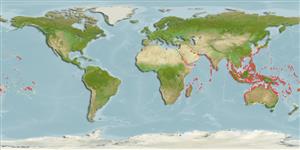Preferred temperature (Fonte Biblio.
123201): 21.9 - 29.3, mean 28.2 °C (based on 3494 cells).
Phylogenetic diversity index (Fonte Biblio.
82804): PD
50 = 0.5000 [Uniqueness, from 0.5 = low to 2.0 = high].
Bayesian length-weight: a=0.02455 (0.01409 - 0.04276), b=3.07 (2.92 - 3.22), in cm total length, based on LWR estimates for this species & Genus-body shape (Ref.
93245).
Trophic level (Fonte Biblio.
69278): 2.6 ±0.4 se; based on diet studies.
Generation time: 1.3 ( na - na) years. Estimated as median ln(3)/K based on 1
growth studies.
Resilienza (Fonte Biblio.
120179): Alto, tempo minimo di raddoppiamento della popolazione meno di 15 mesi (K=0.85).
Prior r = 1.20, 95% CL = 0.79 - 1.80, Based on 1 data-limited stock assessment.
Fishing Vulnerability (Ref.
59153): Low vulnerability (16 of 100).
🛈
Nutrients (Ref.
124155): Calcium = 96 [50, 151] mg/100g; Iron = 0.795 [0.479, 1.283] mg/100g; Protein = 18.5 [17.3, 19.6] %; Omega3 = 0.0986 [, ] g/100g; Selenium = 28.3 [15.8, 53.3] μg/100g; VitaminA = 45.1 [12.6, 153.4] μg/100g; Zinc = 1.55 [1.06, 2.23] mg/100g (wet weight);
